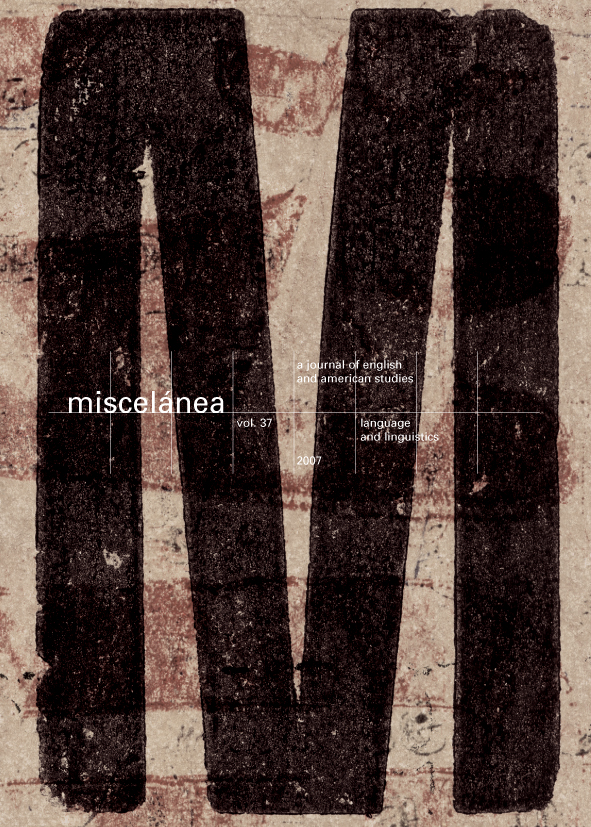Cómo el inventario de fonemas cambia su forma: Un enfoque cognitivo de la evolución y cambios fonológicos
DOI:
https://doi.org/10.26754/ojs_misc/mj.20089704Palabras clave:
Fonología cognitiva, Cambio fonético, Cambio semántico, Inglés Antiguo, Variación lingüísticaResumen
En este artículo proponemos una interpretación de una serie de cambios fonológicos ocurridos a lo largo de la historia del inglés (por ejemplo fractura vocálica en inglés antiguo o el gran desplazamiento vocálico del inglés moderno temprano) desde un punto de vista de la fonología cognitiva. Basamos nuestro análisis en Nathan (1986, 1995, 1996), que aplica la teoría de los prototipos a la descripción fonológica. En procesos de cambio fonológico, los fonemas cambian su número de efectos prototípicos. Desde este punto de vista, propondremos una clasificación basada en dos de estos efectos prototípicos: grado de altura y grado de periferalidad. Al tratar las unidades fonológicas y semánticas como categorías mentales, intentaremos demostrar cómo los principios de categorización y generalización motivan patrones diacrónicos similares tanto en el dominio fonológico como en el semántico.
Descargas
Referencias
Blevins, Juliette. 2004. Evolutionary Phonology: The Emergence of Sound Patterns. Cambridge: Cambridge U. P.
Díaz Vera, Javier E. 2001. “Fonología medieval: La lengua inglesa entre dos mutaciones vocálicas”. In de la Cruz, I. and J. Martín (eds.) Lingüística Histórica Inglesa. Madrid: Ariel: 109-160.
Eddington, David. 2007. “Flaps and Other Variants of /t/ in American English: Allophonic Distribution without Constraints, Rules, or Abstractions.” Cognitive Linguistics, 18 (2): 23-46.
Giegerich, Heinz J. 1992. English Phonology. An Introduction. Oxford: Oxford U. P.
Gussenhoven, Carlos. 2007. “A Vowel Height Split Explained: Compensatory Listening and Speaker Control.” In Cole, J. and J. I. Hualde (eds.) Laboratory Phonology 9. Berlin/New York: Mouton de Gruyter: 145-172.
Guzmán González, Trinidad. 2005. “Revisiting the Revisited: Could we Survive without the Great Vowel Shift?” Studia Anglica Posnaniensia: International Review of English Studies, 39: 121- 132.
Hampton, James. 1993. “Prototype Models of Concept Representation.” In Van Mechelen, I. J. Hampton, R. S. Michalski and P. Theuns (eds.) Categories and Concepts: Theoretical Views and Inductive Analysis. London: Academic Press: 67-95.
Labov, William. 1994. Principles of Linguistic Change I: Internal Factors. Oxford: Blackwell.
Labov, William, Malcah Yaeger and Richard Steiner. 1972. A Quantitative Study of Sound Change in Progress. Philadelphia: US Regional Survey.
Lakoff, George. 1987. Women, Fire, and Dangerous Things: What Categories Reveal about the Mind. Chicago: University of Chicago Press.
—. 1993. “Cognitive Phonology.” In Goldsmith, John A. (ed.) The Last Phonological Rule: reflections on Constraints and Derivations. Chicago: University of Chicago: 117-145.
Langacker, Ronald W. 1991. Concept, Image, and Symbol: The Cognitive Basis of Grammar. Berlin: Mouton de Gruyter.
—. 1999. Grammar and Conceptualization. Berlin: Mouton.
Lass, Roger. 1984. Phonology. Cambridge: Cambridge U. P.
—. 1994. Old English. A Historical linguistic Companion. Cambridge: Cambridge U. P.
Lindblom, Björn. 1963. “Spectographic Study of Vowel Reduction.” Journal of the Acoustic Society of America, 65: 1773-81.
—. 1990. “Explaining Phonetic Variation: Sketch of the HandH Theory.” In Hardcastle, W. J. and A. Marchal (eds.) Speech Production and Speech Modelling. Dordrecht: Kluwer Academic Publisher.
McCombs, Candalene J. 2006. “The Acoustic Properties of Vowels: A Tool for Improving Articulation and Comprehension of English.” Forum on Public Policy Online, Fall 2006 edition. http://www.forumonpublicpolicy.com/archive06/mccombs.pdf (accessed September 24, 2007).
Nathan, Geoffrey S. 1986. “Phonemes as Mental Categories.” Proceedings of the Annual Meeting of the Berkeley Linguistics Society, 12: 212-223.
—. 1995. “How the Phoneme Inventory Gets its Shape—Cognitive Grammar’s View of Phonological Systems.” Rivista di Linguistica, 6.2: 275-287.
—. 1996. “Steps toward a cognitive Phonology.” In Hurch, Bernhard and Richard Rhodes (eds.) Natural phonology: The State of the Art. Berlin: Mouton de Gruyter: 107-120.
—. 2006. “Is the Phoneme Usage-based? – Some issues.” International Journal of English Studies, 6.2: 173-194.
Rosch, Eleanor and Carolyn B. MERVIS. 1975. “Family Resemblances.” Cognitive Psychology, 7: 573-605.
Sweetser, Eve. 1990. From Etymology to Pragmatics. Cambridge: Cambridge U. P.
Taylor, Jeremy. 1995. Linguistic Categorization: Prototypes in Linguistic Theory. Oxford: Clarendon Press.
Thomas, Erik T. 2000. “Reevaluating and Refining Peripherality.” ERIC Document ED 452 711.
Valimaa-Blum, Riita. 2006. Cognitive Phonology in Construction Grammar: Analytic Tools for Students of English. Berlin: Mouton.
Vázquez-González, Juan Gabriel. 2005. Diccionario conceptual de verbos para la donación en inglés antiguo. Huelva: Universidad de Huelva.
Vihman, Marilyn May. 1996. Phonological Development. The Origins of Language in the Child. Oxford: Blackwell.
Descargas
Publicado
Número
Sección
Licencia
Derechos de autor 2008 Javier Enrique Díaz Vera

Esta obra está bajo una licencia internacional Creative Commons Atribución-NoComercial 4.0.


